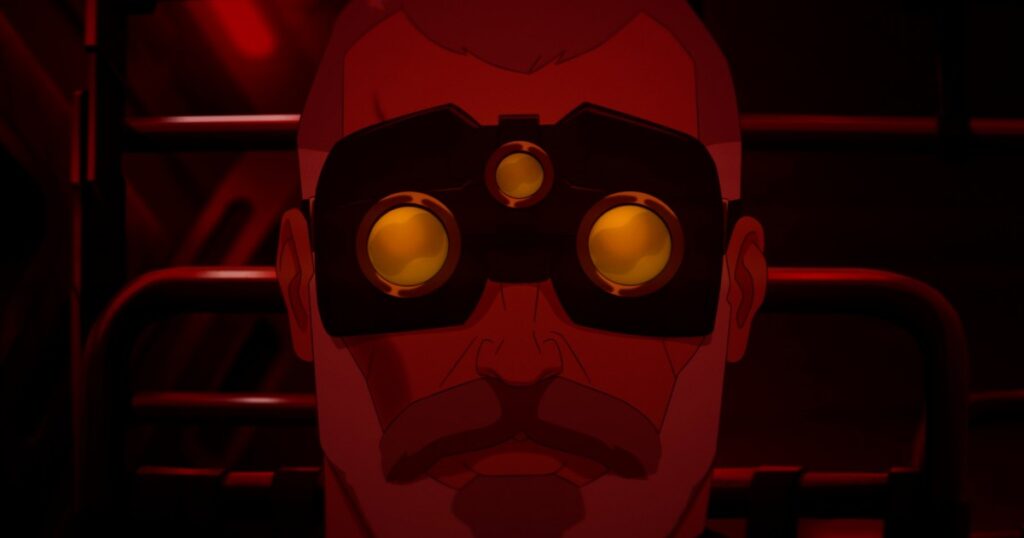
It’s been more than a decade since there was a proper Splinter Cell game. So when Derek Kolstad, a writer best-known for creating the John Wick series, approached making the new animated Netflix adaptation, he treated it as if the story continued as the games were dormant. “I wanted to do it almost like the timeline kept going since the last game,” Kolstad tells The Verge. At the outset of the show, called Deathwatch, the iconic Sam Fisher finds himself in a new phase of life: “Retired on a farm in the middle of nowhere, surprised that he’s survived.” Of course, it’s not long before things go wrong.
Deathwatch sees this newly settled version of Fisher (who is now voiced by Liev Schreiber, taking over for Michael Ironside) quickly pulled back into action when he’s forced to help a younger agent who has been injured and stranded from her team. Initially we see him sipping tea and hanging out with his dog Kaiju, but as soon as the agent Zinnia (Kirby Howell-Baptiste) shows up at his door, he’s thrust back into a globe-trotting journey filled with guns, gadgets, and oh-so-many bloody stealth kills.
Kolstad, who grew up on Tom Clancy novels as a kid, says Ubisoft largely gave him free rein to approach the story how he wanted. “Maybe it’s because there hasn’t been a Splinter Cell game in quite some time, they just kind of let me go with it,” he says. “Once I explained that I was doing Old Man Logan by way of Point Blank, they understood what I was trying to do.”
Given the amount of time that has passed since the last Splinter Cell title, Kolstad says he wanted to “introduce the character simply” to make it easier for newcomers to jump in. But he still wanted to make sure this was the same Sam Fisher that fans knew and loved — only a little older. “Adaptations are tough,” Kolstad says. “To move from one medium to the next, you have to build out new things, and you’re losing stuff. I made sure that we retained his history as best we could.”
This isn’t Kolstad’s first time playing around in an existing universe; he also wrote several episodes of the Marvel series The Falcon and the Winter Soldier. But this was his first time working in the realm of animation, which was a big shift. There was a less tangible aspect to the show’s creation. Kolstad could see art and animatics but wasn’t able to visit a set like he would on a live-action production. “When the scripts are done, you’re kind of like ‘Cool, let’s see what happens in two and a half years.’ That’s the weirdest thing,” he says, adding that “there’s still some of that wizard behind the current element that I don’t understand, but I trust the people doing it.”
One benefit of animation, though, is that there are fewer constraints when it comes to the action, as you don’t have to worry as much about things like budget, safety, or, um, gravity. Even still, Kolstad says that he remained largely restrained with Deathwatch’s action — even if there are motorcycle chases and plenty of explosions — primarily because it fit the world and character better.
“I could write the biggest action scene in the world, and it’ll cost a little bit more — because you’re animating many more elements — but in live action, a $30 million budget becomes a $150 million budget,” he explains. “So they encouraged me to go as big as I could. But to be honest, I like the moments of intimate action. I like the sneaking, I like the goggles. All of these intimate sequences are just as cool.”
There also, perhaps unsurprisingly, is a bit of a John Wick feel to Deathwatch. You can see it in the slick and brutal action but primarily in the setup, in which a veteran killer starts out hoping to live out their life in peace with a cute dog before things turn sour. There’s one key difference between the two, though, according to Kolstad: “This dog survives.”
Splinter Cell: Deathwatch is streaming on Netflix now.

